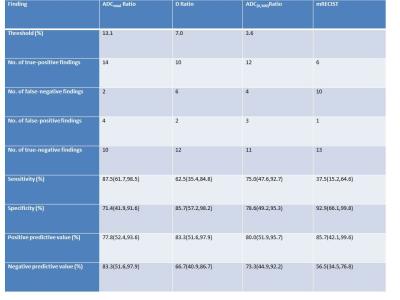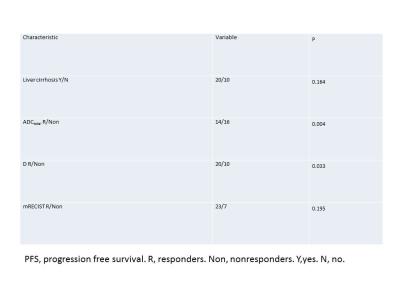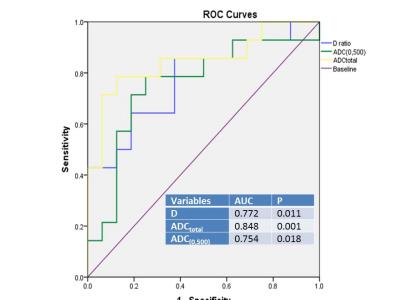5268
ADCtotal Ratio and D Ratio Derived from Intravoxel Incoherent Motion Early after TACE Were Independent Predictors for Survival in Hepatocellular Carcinoma1Radiology, zhongshan hospital, shanghai, People's Republic of China
Synopsis
The purpose of this study was to explore the threshold of IVIM parameters,ADCtotal and ADC(0,500) ratios 24-48 hours after TACE to assess early response in patients with unresectable HCC and to compare the association between diffusion‑weighted imaging with the IVIM-DWI and mRECIST with survival. Our study show that the ADCtotal ratio and D ratio 24-48 hours after TACE were independent predictors for response to TACE for HCC, and showed stronger association with PFS than mRECIST.
Abstract
Purpose: To explore the threshold of intravoxel incoherent motion (IVIM) parameters, apparent diffusion coefficient [ADCtotal and ADC(0,500)] ratios 24-48 hours after transarterial chemoembolization (TACE) to assess early response in patients with unresectable hepatocellular carcinoma (HCC) and to compare the association between diffusion‑weighted imaging with the intravoxel incoherent motion (IVIM-DWI) and mRECIST with survival.
Materials and Methods: Institutional review board approval and informed consent were obtained for this prospective study. 30 patients underwent 1.5-T magnetic resonance imaging (MRI) with IVIM-DWI of 12 b values (0, 10, 20, 30, 40, 50, 70, 100, 200, 300, 500, 800 s/mm2) 1 week before and 24-48 hours after TACE. Response was assessed with the change of true diffusion coefficient (D), pseudo‑diffusion coefficient (D⃰), perfusion fraction (PF), ADCtotal, and ADC(0,500) values relative to baseline and with mRECIST. Receiver operating characteristic (ROC) curve was used to explore the threshold of these parameters ratios. Kaplan-Meier, log rank tests and Cox hazard model were used to correlate the response variables with progression-free survival (PFS) and to assess the incidence and potential clinical risk factors for PFS. Mann-Whitney U test was used to compare the difference in parameters between responders and nonresponders prior to TACE.
Results: Median PFS was 99 days. The threshold of ADCtotal ratio, D ratio, and ADC(0,500) ratio were 13.1% (P=0.001), 7.0% (P=0.011), and 3.6% (P=0.018) with the sensitivity and specificity of 78.6%and 87.5%, 85.7%and 62.5%, 78.6%and 75%respectively (Table 1). The predictive utility of ADCtotal ratio, D ratio and ADC(0,500) ratio for PFS were 0.848, 0.772, and 0.754 respectively (Figure 1). Survival analyses showed ADCtotal ratio, D ratio, ADC(0,500) ratio, liver cirrhosis, and mRECIST had a significant effect on PFS (P<0.05) (Table 2). ADCtotal ratio and D ratio were independent predictors for 99-day PFS (P=0.004, P=0.033). There were no significant differences in pretreatment IVIM-DWI parameters between responders and nonresponders. Conclusion: The ADCtotal ratio and D ratio 24-48 hours after TACE were independent predictors for response to TACE for HCC, and showed stronger association with PFS than mRECIST.
Key Words: HCC; mRECIST; IVIM; ADC; TACE; Response prediction and assessment
Acknowledgements
HCC are too large or multifocal to resect, TACE is widely regarded as the standard of care if in good performance status and preserved liver function. Previous studies have shown that the accuracy of mRECIST and EASL is superior to that of RECIST 1.1 in response evaluation after TACE for HCC. Recently, it has become increasingly recognized that new methods of therapy assessment need to be developed urgently. The investigation for reliable quantitative biomarkers to assess therapeutic response such as functional MR imaging has been desired. A more reasonable bi-exponential model of IVIM to study abdominal tumors, which, using a more sophisticated approach and multi increasing b values, would enable quantitative parameters that separately reflect tissue diffusivity and microcapillary perfusion to be estimated so as to a more accurate evaluation of DWI analysis for response assessment.References
Vandecaveye V, Michielsen K, De Keyzer F, et al. Chemoembolization for hepatocellular carcinoma: 1-month response determined with apparent diffusion coefficient is an independent predictor of outcome. Radiology 2014;270(3):747-757.
Yoon JH, Lee JM, Yu MH, Kiefer B, Han JK, Choi BI. Evaluation of hepatic focal lesions using diffusion-weighted MR imaging: comparison of apparent diffusion coefficient and intravoxel incoherent motion-derived parameters. J Magn Reson Imaging 2014;39(2):276-285.
Figures


